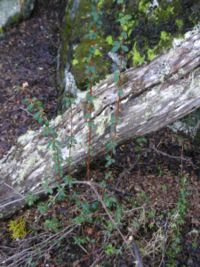Berberis buxifolia
| Berberis buxifolia subsp. var. | Calafate | |||||||||||||||||||||||||||||||||||||||||||||||||||||||
|---|---|---|---|---|---|---|---|---|---|---|---|---|---|---|---|---|---|---|---|---|---|---|---|---|---|---|---|---|---|---|---|---|---|---|---|---|---|---|---|---|---|---|---|---|---|---|---|---|---|---|---|---|---|---|---|---|

|
|
| ||||||||||||||||||||||||||||||||||||||||||||||||||||||
| ||||||||||||||||||||||||||||||||||||||||||||||||||||||||
Berberis buxifolia, common name the Magellan Barberry, in Spanish Calafate, is an evergreen shrub, with shiny box-like leaves. The Calafate is native to the south of Argentina and Chile and is a symbol of Patagonia.
The bush grows to a height of 1 - 1.5 m. It has many arching branches, each covered in many tripartite spines. The bush has many small yellow flowers in summer. Its edible blue-black berries are harvested for jams, but are eaten fresh too - a legend tells that anyone who eats a Calafate berry will be certain to return to Patagonia.
The Calafate is grown commercially for its fruit, potential medical uses and as a garden plant or bonsai. Its wood is used to make a red dye. The cultivar Berberis buxifolia 'Nana' is widely available as a garden shrub, and is also used in commercial plantings as a low spiny hedge to discourage intruders, but it does not fruit.
| Standard Cyclopedia of Horticulture |
|---|
|
Berberis buxifolia, Poir. (B. dulcís, Sweet). One to 3 ft.: branches brown, grooved; spines usually 3-parted, short: Lvs. cuneate, obovate or elliptic, ⅓-1 in. long: fls. solitary, on long pedicels, orange-yellow: fr. nearly globose, blackish purple. May. Chile to Strait of Magellan.—A very graceful, free-flowering shrub; one of the hardiest of the evergreen species; will stand the winter even N. if somewhat protected.
|
Cultivation
Propagation
Pests and diseases
Varieties
Gallery
-
photo 1
-
photo 2
-
photo 3
References
- Standard Cyclopedia of Horticulture, by L. H. Bailey, MacMillan Co., 1963
External links
- w:Berberis buxifolia. Some of the material on this page may be from Wikipedia, under the Creative Commons license.
- Berberis buxifolia QR Code (Size 50, 100, 200, 500)
